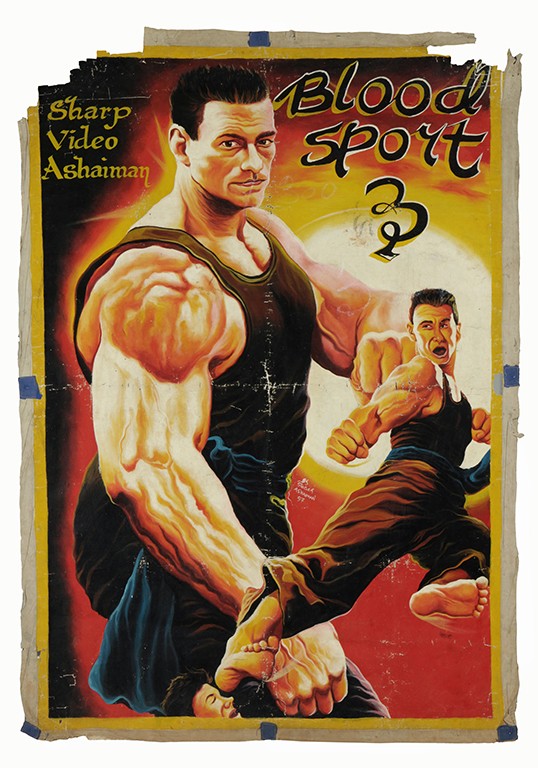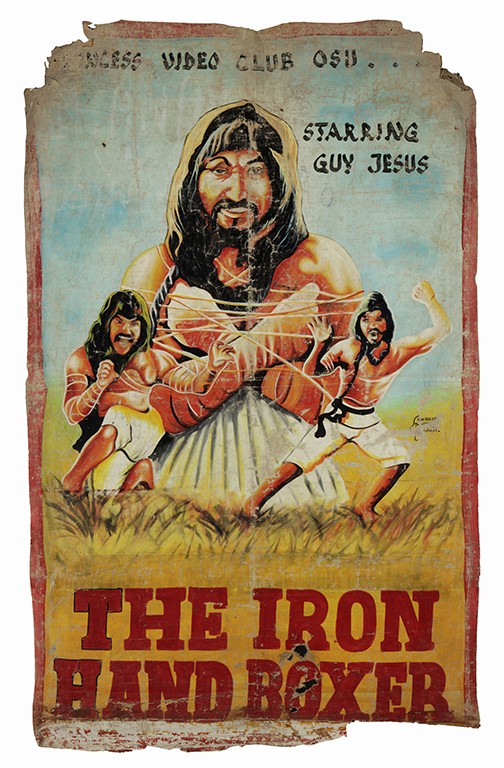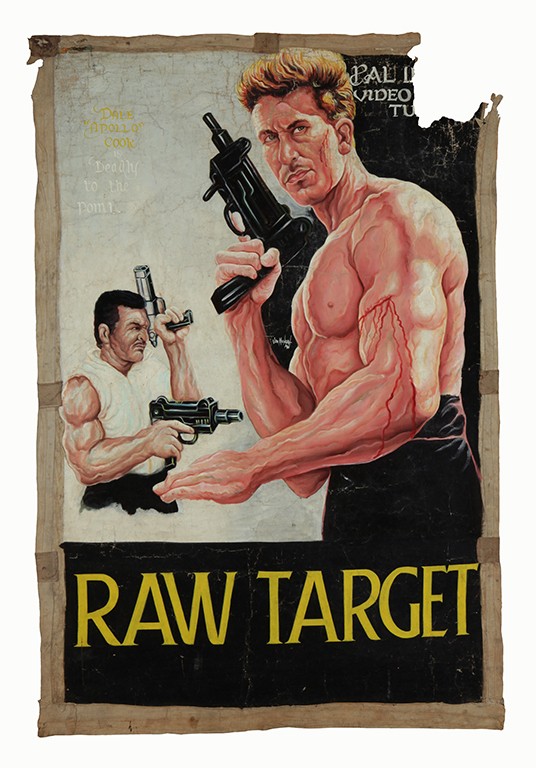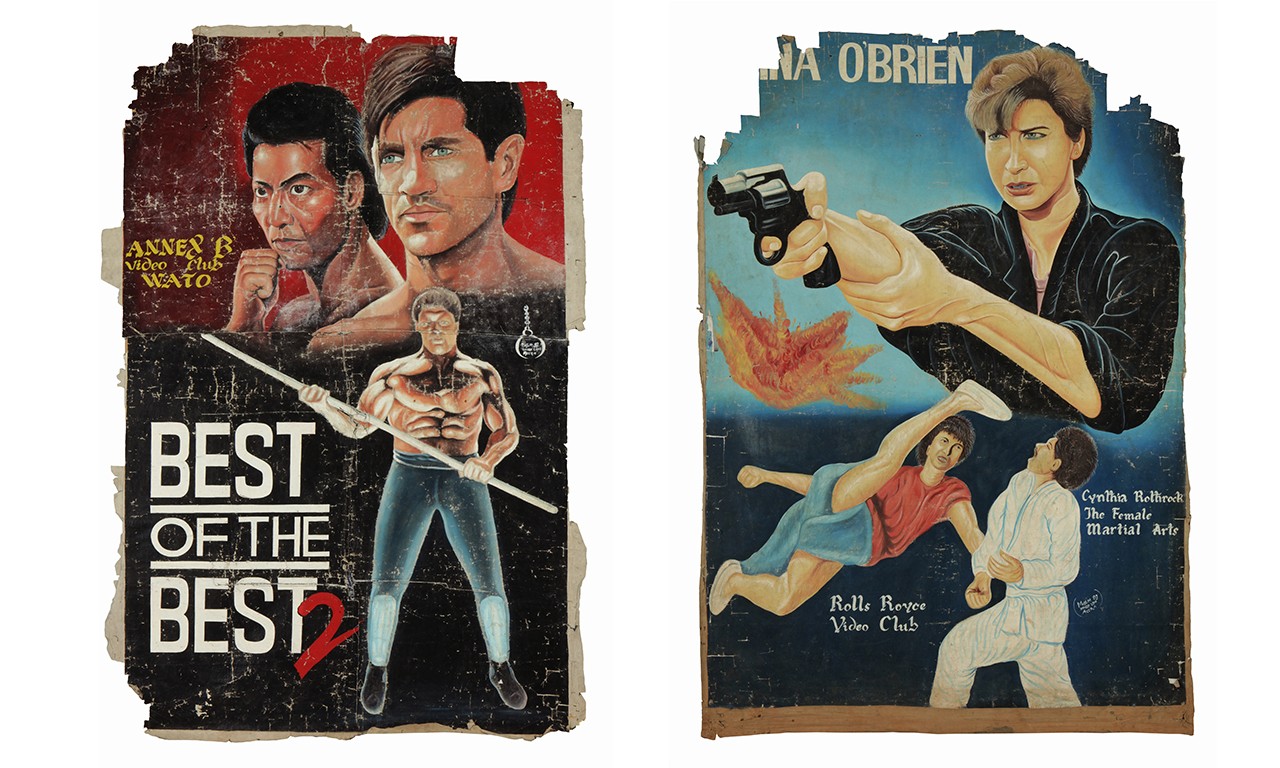 |
New Killers in Town, 1996
Jonas Golden Boy (Ghanaian)
Oil on cotton canvas; 62 × 47 in.
2014.28.30
Gift of Jay and Helen Lavely |
Three is the Magic Number
In a world where movie theaters are threatened by a global pandemic, one group offers a respite from the doldrums of home quarantine: Ghanaian poster painters. Three long years have passed since the heroes of Ghana’s golden age of movie poster painting—a time in the ‘80s and ‘90s when entrepreneurs roamed the West African country with VHS players and generators and commissioned wonderful canvas paintings as advertisements—were featured in Bowers Museum’s the cult hit exhibition, Reel Art: Movie Posters from Ghana. This spring, Reel Art’s familiar cast of characters returns, only this time there’s a twist: they’ve gone cyber. To commemorate the launch of Bowers at Home’s first virtual exhibition we navigate the torturous, canyon-like topographies of these posters’ musculature for a third time. Here we look at the artists themselves, the decisions they made in terms of composition and subjects, how they entered the industry and the things that inspired them to paint.
 |
Blood Sport 3, 1997
Jasper (Ghanaian, 1972 - )
Oil on cotton canvas; 67 × 46 in.
2014.28.26
Gift of Jay and Helen Lavely |
Disappearing Act
Posters are a unique artistic medium in that it is generally the artist and not the subject that disappears into the work. Perusing the illuminated boxes beneath a marquis, in the United States we look at Photoshopped, photographic likenesses of our favorite actors before making our decisions about the film we are going to see. But as scholars of these hand-painted posters have noted, it is not the actors who are the protagonists of Ghanaian film posters—beautifully mishappen lumps of rippling biceps that they are—but the artists themselves. Much in the same way that Warhol and Rauschenberg took ownership of American foodstuffs and celebrities, these posters effectively stake their claim on the movies they advertise. The benefit of these artworks having been made by individuals rather than production companies is that they are distinct enough that the trained eye can tell exactly who had painted one just by looking at the canvas, billowing plumes of flame, vasculature of muscles, use of color and features.
 |
The Iron Hand Boxer, c. 1995
Socretes, (Ghanaian, 1965 - )
Oil on cotton canvas; 69 × 43 in.
2014.28.15
Gift of Jay and Helen Lavely |
Case by Case Basis
The original post and sequel in this series looked at how in many cases artists might have only seen the cover of a VHS tape or had the movie described to them before they began painting, but what they do not explore is just how much consideration went into the various elements seen in these posters. Pulling an audience together is tough. Savvy consumers as a rule of thumb need some prodding to be separated from their money. These posters had to be more than invitations, they had to be imperatives. Sex, explosions, violence and both biological and mechanical monsters were the vices both American and Ghanaian audiences were interested in when they went to see an action movie, but without any committee decision-making, fear of spoiling plot points, or liability if viewers were disappointed; Ghanaian artists could include subjects that never even appeared in the films. If anything, it’s a little surprising that the Bowers’ poster for Blood Sport 3 wouldn’t feature a drop of blood, but that Leonardo’s poster for Mrs. Doubtfire has Robin Williams’ character gouging an eye out with a broom handle just indicates that some creative liberties were taken. Artists made all the decisions except whether they would get their next commission, meaning they were only beholden to creating the most incredible pieces possible. They were advertising agencies of one.
 |
Raw Target, 1996
Joe Mensah (Ghanaian, 1966 - )
Oil on cotton canvas; 68 × 46 in.
2014.28.28
Gift of Jay and Helen Lavely |
History of Action
What has been less studied is the incorporation of traditional West African motifs and the larger historical context of these artworks. In Ghana, crossed swords represent courage, heroism and power, much in the same way that bald eagles evoke patriotic thoughts in Americans. The snakes appearing in so many of these posters would remind any Ghanaian of the archetypal myths of a legendary battle against evil that they heard as children. Anakwa Dwamena, a Ghanaian writer, noted that this golden age took place during a period of political freedom following a series of several dictatorships. Golden eras are the result of specific sets of conditions and are rarely long-lasting, yes the introduction of new technologies made theaters and entrepreneurs travelling the Ghanaian interior with movies possible, but to what degree did other factors make people receptive to these works?
 |
Best of the Best 2 and China O’Brien, 1993
Muslim (Ghanaian)
Oil on cotton canvas
2014.28.22,.16
Gift of Jay and Helen Lavely |
League of Extraordinary Gentlemen
Lastly, how did these pseudonymous artists go from being painting enthusiasts to building whole careers around the work during the golden age? As is the case with any group of artists, it happened very differently for each of them, but was originally born out of a mid 20th century tradition of roadside painting in Ghana and a system of apprenticing. Many of the most famous artists learned from masters only a few years their senior. Aliases like Muslim and Socrates also hint that this is an art which is intrinsically tied to the spirituality and philosophy of its creators. D.A. Bright Obens attributed his talent to God, Jasper focused so much on beef and brawn because he was himself body builder, and Leonardo saw painting as satiation for the soul. And art is food for the soul. Whether it’s a B-action flick in which a kickboxing champion has some flimsy excuse to crack skulls or a Ghanaian painting made to advertise it in a bygone time, never forget that art is what we turned to when the whole world turned on its head!
If you have not yet taken a look, click or tap here to see the virtual exhibition Reel Art: Movie Posters from Ghana. For related activities, click or tap here to look at other offering on Bowers at Home.
Text and images may be under copyright. Please contact Collection Department for permission to use. Information subject to change upon further research.






Comments